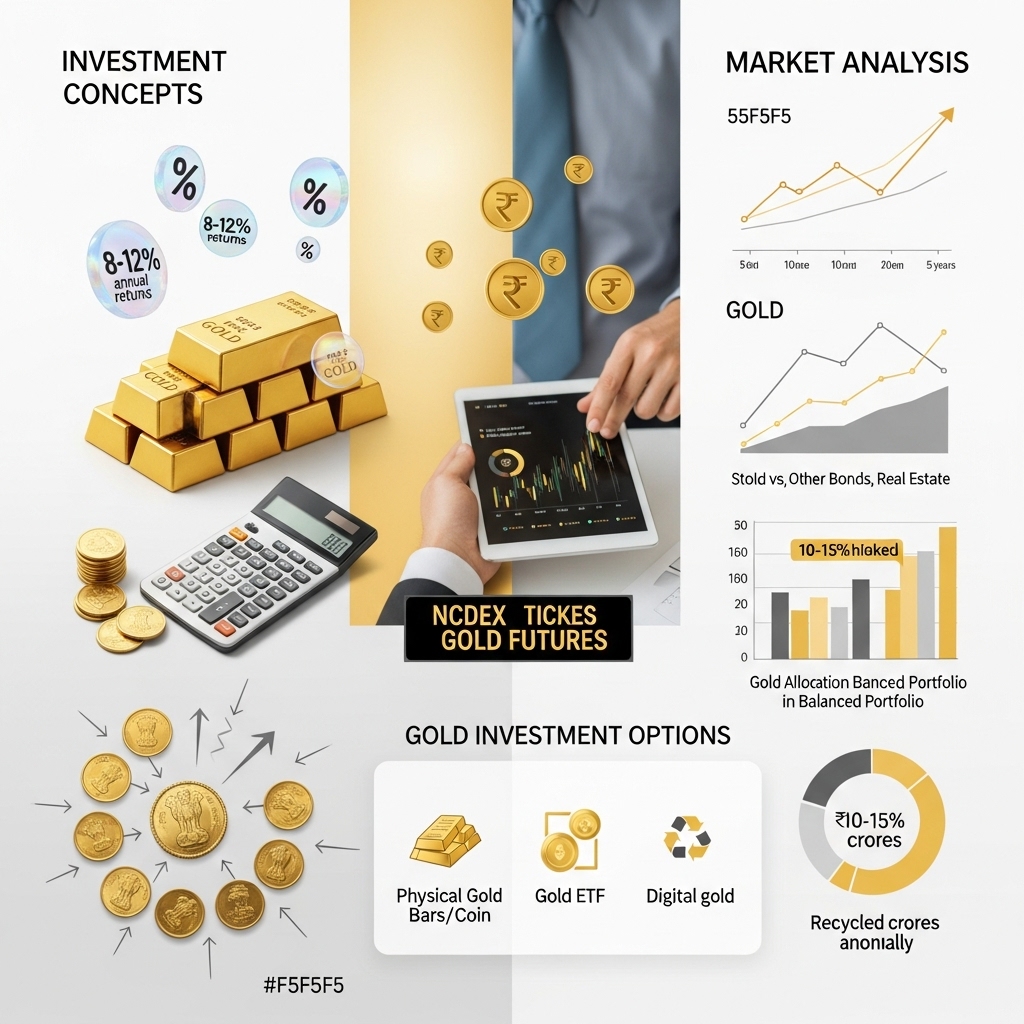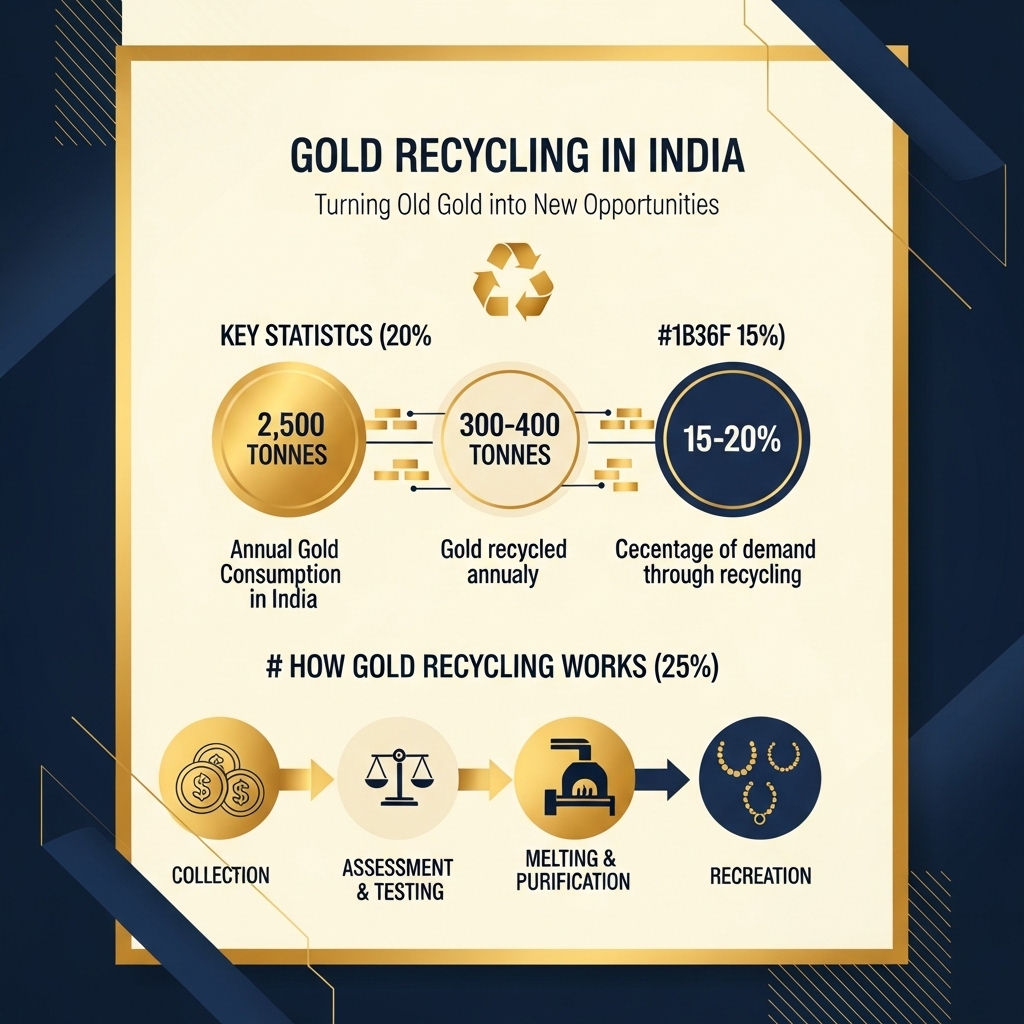The Hidden Gold Market That’s Reshaping India’s Investment Landscape
While gold prices surge past $2,000 per ounce and central banks continue their unprecedented buying spree, savvy investors are overlooking a massive market opportunity hiding in plain sight. India’s gold recycling industry processes over 300 tonnes annually—nearly 15% of the country’s total gold supply—creating ripple effects that directly impact global gold prices and investment strategies.
For gold investors, understanding India’s recycling ecosystem isn’t just academic curiosity—it’s essential market intelligence. As the world’s second-largest gold consumer, India’s recycling patterns provide crucial insights into supply dynamics, price trends, and emerging investment opportunities. When economic pressures mount or gold prices peak, Indian households typically increase their recycling activity, flooding the market with supply that can influence international prices within weeks.
This comprehensive analysis will explore how India’s sophisticated gold recycling network operates, from neighborhood jewelry shops to large-scale refineries, and examine its profound impact on global gold markets. We’ll uncover the financial mechanisms driving recycling decisions, analyze how these trends affect gold prices, and reveal strategic insights that forward-thinking investors can leverage. Whether you’re building a portfolio hedge or timing market entries, understanding this $15 billion recycling market could be the competitive edge you’ve been seeking in your gold investment strategy.
Gold Market Analysis and Key Insights
Current Market Performance and Trends
India’s gold market has demonstrated remarkable resilience, with recycled gold comprising approximately 15-20% of total domestic supply. The domestic gold price has maintained an upward trajectory, reaching ₹62,000-65,000 per 10 grams in 2024, driven by global uncertainties and rupee depreciation. Gold recycling volumes have increased by 25% year-over-year, as investors capitalize on favorable pricing conditions while maintaining portfolio exposure through strategic rebalancing.
Investment Benefits of Gold Recycling
Recycling presents compelling investment advantages beyond traditional buying strategies. Investors can unlock immediate liquidity from idle gold assets while avoiding complete market exit. The process typically yields 85-95% of current market value, depending on purity and market conditions. Transaction costs remain significantly lower than selling and repurchasing, making recycling an efficient portfolio optimization tool. Additionally, investors benefit from immediate cash flow for alternative investments while maintaining core gold allocation through retained holdings.
Strategic Considerations for Investors
Modern investors must evaluate recycling timing against market cycles and personal financial objectives. Gold’s negative correlation with equity markets makes partial recycling attractive during economic stability, allowing diversification into growth assets. However, geopolitical tensions and inflationary pressures support maintaining substantial gold positions. The emergence of digital gold platforms and gold ETFs provides alternative liquidity options that complement physical gold recycling strategies.
Expert Recommendations
Financial advisors recommend treating gold recycling as a dynamic portfolio management tool rather than permanent asset disposal. Optimal strategies involve recycling lower-purity ornamental gold while retaining investment-grade bullion. Investors should monitor gold-to-equity ratios, targeting recycling when gold allocation exceeds 15-20% of total portfolio value. Timing recycling activities during festive seasons can maximize returns due to increased demand. Additionally, investors should maintain detailed documentation of recycled gold transactions for tax optimization and future investment planning, ensuring compliance with regulatory requirements while maximizing after-tax returns.

Gold Investment Strategies and Options
India offers diverse gold investment avenues, each serving different financial objectives and risk appetites. Understanding these options is crucial for building a balanced portfolio that incorporates gold’s unique benefits.
Physical Gold vs. Paper Gold
Physical gold includes jewelry, coins, and bars, providing tangible asset ownership but incurring storage and insurance costs. Paper gold investments—Gold ETFs, Gold Mutual Funds, and Digital Gold—offer liquidity and convenience without physical storage concerns. Gold ETFs track gold prices directly, while Gold Mutual Funds invest in gold-related securities, providing professional management.
Strategic Portfolio Allocation
Financial advisors typically recommend allocating 5-10% of your portfolio to gold as a hedge against inflation and market volatility. Conservative investors might prefer physical gold or ETFs, while aggressive investors could explore gold mining stocks or futures. Gold’s negative correlation with equities makes it an effective portfolio diversifier during economic uncertainty.
Risk Assessment Considerations
Gold investments carry market risk, with prices influenced by global economic conditions, currency fluctuations, and central bank policies. Physical gold involves theft and storage risks, while paper gold faces counterparty risks. However, gold’s historical value preservation makes it relatively stable during geopolitical tensions.
Market Timing Strategies
Successful gold investing often involves dollar-cost averaging rather than timing the market. Consider increasing gold allocation during high inflation periods or economic instability. Monitor factors like real interest rates, USD strength, and central bank monetary policies for investment timing.
The rise of gold recycling markets adds another dimension—recycled gold often trades at slight discounts, presenting potential value opportunities for informed investors seeking to optimize their gold investment strategies.
Market Performance and Outlook
Historical Performance and Growth Trajectory
India’s gold recycling market has demonstrated remarkable resilience and growth over the past decade. Historical data reveals that recycled gold has consistently accounted for 15-25% of India’s total gold supply, with volumes reaching 75-100 tonnes annually. The sector experienced significant expansion during economic uncertainties in 2008, 2016 (demonetization), and 2020-2021 (COVID-19 pandemic), when gold recycling volumes surged by 30-40% as households liquidated assets.
Current Market Dynamics
The current gold recycling landscape reflects robust activity driven by elevated gold prices hovering around ₹60,000-65,000 per 10 grams. Urban centers like Mumbai, Delhi, and Chennai have witnessed increased participation from organized players, with technology-enabled platforms facilitating transparent pricing and convenient transactions. The market is transitioning from traditional, unorganized operations to structured, technology-driven businesses.
Economic Factors and Price Influences
Gold prices in India remain sensitive to global factors including US dollar strength, Federal Reserve policies, geopolitical tensions, and domestic factors like import duties and GST regulations. Inflation concerns and currency fluctuations significantly impact recycling volumes, as higher prices encourage more households to recycle.
Future Projections
Industry analysts project steady growth in India’s gold recycling sector, with volumes potentially reaching 120-150 tonnes by 2030. Digital adoption, environmental consciousness, and regulatory support are expected to drive formalization. The integration of blockchain technology for transparency and expanding rural reach through fintech partnerships position the sector for sustained expansion.
Frequently Asked Questions About Gold Investment
How does gold recycling work in India?
Gold recycling involves melting down old jewelry, coins, and ornaments to extract pure gold. Professional refiners assess purity, weigh items, and offer payment based on current market rates minus processing fees. The recycled gold is then refined and reused for new jewelry or investment products.
Is recycled gold as valuable as new gold?
Yes, once properly refined, recycled gold maintains the same purity and market value as newly mined gold. The intrinsic value depends solely on weight and purity, not origin. Recycled gold often costs less due to lower processing expenses compared to mining.
What are the tax implications of selling old gold?
Gold held for over three years qualifies for long-term capital gains tax at 20% with indexation benefits. Short-term gains are taxed as per your income slab. Maintain purchase receipts and documentation for accurate tax calculation.
How is the purity of recycled gold determined?
Professional assayers use electronic gold testers, acid tests, or fire assay methods to determine exact purity levels. Hallmarked jewelry provides initial reference, but testing ensures accurate assessment for fair pricing.
Why does gold recycling matter for investors?
Gold recycling reduces environmental impact from mining, provides cost-effective gold acquisition, and maintains market liquidity. It offers investors an affordable entry point while supporting sustainable precious metal practices.

Final Thoughts on Gold Investment
Gold recycling in India represents a sophisticated ecosystem that directly impacts global gold markets and investment opportunities. For investors, the key takeaways are clear: India’s recycling infrastructure creates market stability, reduces price volatility during supply shortages, and demonstrates gold’s enduring liquidity as an asset class.
The circular nature of India’s gold economy—where jewelry becomes investment bars and vice versa—validates gold’s fundamental value proposition: it never loses its intrinsic worth. This recycling system provides a natural price floor and ensures consistent market demand.
Investment Recommendation: Allocate 5-10% of your portfolio to physical gold, leveraging India’s recycling dynamics for long-term wealth preservation.
Ready to capitalize on gold’s proven resilience? Start building your gold investment strategy today by consulting with certified precious metals dealers and exploring both physical gold and gold ETF options.